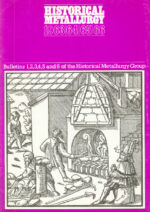Journal Contents
'The adventitious production of iron in the smelting of copper' revisited: metallographic evidence against a tempting model
J Merkel and K Barrett
Pages 59-66
The concentrations and distributions of copper in corroded iron artefacts are critical for interpreting the origin of the iron metal. Microanalysis and copper element distribution maps of twelve iron artefacts from the Egyptian New Kingdom (14th-12th century BC) Temple at Timna/Wadi Mene ‘iyeh near Elat-Aqaba show gradients indicating contamination by copper from the burial environment. While metallic iron can be a by-product from copper smelting, it seems unlikely it was collected and forged into iron objects. These twelve iron artefacts are the products from iron smelting, not by-products from copper smelting.
Iron, copper and tin at Baratti, Populonia: smelting processes and metal provenances
M Benvenuti, I Mascaro, P Costaglioia, G Taneiii and A Romuaidi
Pages 67-76
If the role of Populonia-Baratti as one of the most important ironworking centres of Europe in the 1st millennium EC is well documented, information about non-ferrous metal production in the area is still very scanty. We therefore started a detailed research program on four main excavation sites in the Populonia-Baratti industrial zone (Poggio della Porcareccia, Casone, Campo VI and the Baratti beach deposit) with the aim of establishing the types and extent of metallurgical activities for non-ferrous metals (mainly copper and tin), as well as on the provenance of smelted ores in the Etruscan period (c7th-3rd century BC). From analysis of stratigraphic relationships, morphological, mineralogical, textural, and chemical features of metallurgical materials we obtained the following main results:
• although remaining archeometallurgical evidence at Baratti-Populonia can largely be ascribed to iron production, the existence of an earlier (and partly coeval) copper metallurgy is also well documented, particularly in the Baratti beach deposit
• two different types of copper slags, which could be related to different metallurgical steps, have been distinguished
• the mineralogical and compositional features of slags from the sites investigated could provide indirect evidence of local bronze production (in agreement with archaeological data), by employment of tin-rich ores
• analysis indicates that iron ores came was mainly from Elba and, to a lesser extent, from the Campiglia Marittima district, whereas copper and tin are mostly derived from the latter area
Examination of a moulding plane blade from Yindolanda
David N Sim and Isabel M L Ridge
Pages 77-82
This paper gives an overview of the use of the carpenter’s plane in Roman civilization. A general review is made of the planes and plane irons which are known in the archaeological record. Metallo graphic examination is made of a Roman moulding plane blade found at Vindolanda, on Hadrian’s Wall in Northumberland (NGR: NY7766). The blade was made of a laminar structure of steel and iron. The cutting edge was left unhardened, which would have made it easy to shape and maintain, whilst being hard enough to create the fine mouldings such as are found on the Roman furniture uncovered at Pompeii and Herculaneum.
A note on the analysis of crucibles and moulds
David Dungworth
Pages 83-86
Crucibles and moulds are routinely analysed using energy dispersive X-ray fluorescence in order to determine the sorts of metals that may have been melted or cast in them. The interpretation of the results needs to be approached with caution as the proportions of metallic elements are not the same as those in the original melt. Data available from the thermochemical literature is explored as a first step towards understanding how metallic elements become incorporated into crucibles and moul
Liquid steel in Anglo-Saxon England
I Mack, G McDonnell, S Murphy, P Andrews and K Wardley
Pages 87-96
Prior to Huntsman’s discoveries in Sheffield in the 1740s, steel production in Western Europe, and in England in particular, has been assumed to be by solid-state carburization of malleable iron, a process often referred to as cementation. Here we present archaeometallurgical data that Saxon smiths in 8th-9th century AD England were using decarburization of molten cast iron to produce steel of comparable quality to that produced by Huntsman 1000 years later. The evidence derives from metallurgical analysis of edged tools and stock iron, and crucially the analysis of pieces of ferrous material that lack distinctive artefactual form. The evidence presented here will necessitate a re-assessment of Saxon ironworking technology and the early occurrence of cast iron fragments in the archaeological record, and has far-reaching implications for our (lack of) understanding of the development of iron technology.
The Netherhall Blast Furnace, Maryport
Ian Miller
Pages 97-
In response to a condition on a planning application, the site of the Netherhall blast fiimace, Maryport (NY 036 362), was subjected to a rapid archaeological investigation by the Lancaster University Archaeological Unit (LUAU) in 1993. A range of archive sources was consulted, many of which received archaeological support and clarification in the subsequent evaluation and excavation, which established the layout of the fiimace complex, and has resolved the uncertainty of the arrangement for the water supply. The results have further indicated that the furnace was designed to operate on cokefiiel, placing Netherhall at the forefront of 18th centiny blast fumace technology.





There are no reviews yet.